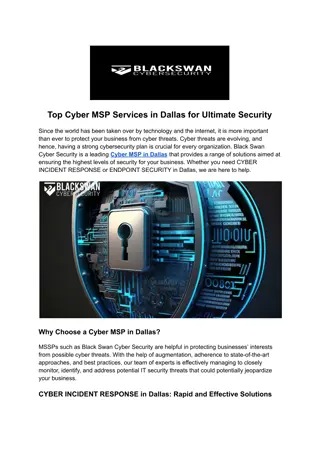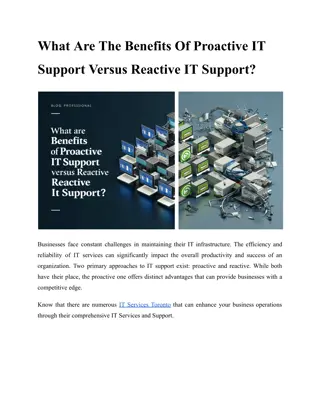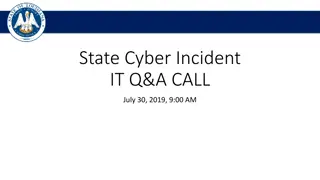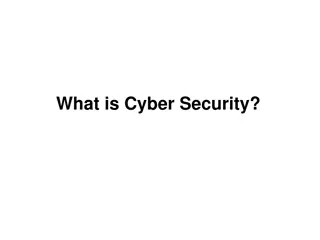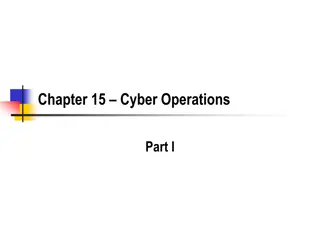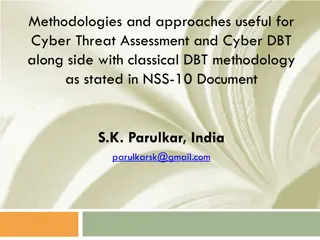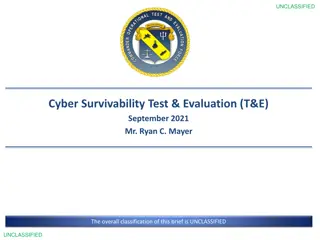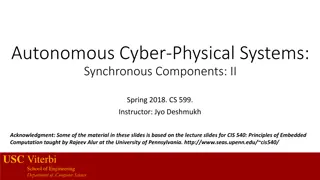
Balancing Proactive and Reactive Cyber Defenses
Learn how to balance proactive and reactive strategies in cyber defense. Protect your business with a comprehensive security approach.n
Download Presentation

Please find below an Image/Link to download the presentation.
The content on the website is provided AS IS for your information and personal use only. It may not be sold, licensed, or shared on other websites without obtaining consent from the author. If you encounter any issues during the download, it is possible that the publisher has removed the file from their server.
You are allowed to download the files provided on this website for personal or commercial use, subject to the condition that they are used lawfully. All files are the property of their respective owners.
The content on the website is provided AS IS for your information and personal use only. It may not be sold, licensed, or shared on other websites without obtaining consent from the author.
E N D
Presentation Transcript
Balancing Defenses Proactive and Reactive Cyber What if your company's most sensitive data was stolen overnight? In a world where cyber threats are constantly evolving, this scenario is all too real. Businesses today face a relentless onslaught of cyber attacks, and the stakes couldn't be higher. How can you safeguard your digital assets against these ever-present dangers? The answer lies in striking the perfect balance between proactive and reactive cyber defenses. Therefore, it is best to get a service of cybersecurity consulting Toronto from top-notch firms. What is Proactive Cyber Defense? Proactive cyber defense is all about anticipating and preventing attacks before they occur. It involves implementing security measures and best practices to create a strong foundation of protection. Here are some key elements of proactive defense: 1. Strong Passwords and Multi-Factor Authentication: Using long, complex passwords is a fundamental proactive measure. But it goes beyond just creating hard-to-guess passwords. Organizations should implement password policies that require regular changes and prevent the use of common or previously breached passwords. Multi-factor authentication adds an extra layer of security by
requiring users to provide additional proof of identity, such as a code sent to their phone or a fingerprint scan. This significantly reduces the risk of unauthorized access even if a password is compromised. 2. Firewalls and Network Segmentation: Firewalls act as a barrier between trusted internal networks and untrusted external networks, like the Internet. They monitor and control incoming and outgoing network traffic based on predetermined security rules. Advanced firewalls can also detect and block suspicious activities that might indicate an attack. Network segmentation involves dividing a network into smaller parts, which can limit the spread of an attack if one segment is compromised. 3. Regular Software Updates and Patch Management: Software vulnerabilities are often the entry point for cyberattacks. Regularly updating software and operating systems ensures that known security holes are patched. This process, known as patch management, involves identifying, acquiring, testing, and installing multiple code changes (patches) to a computer system. It's a continuous process that requires dedicated resources and careful planning to avoid disrupting normal operations. Read More Articles: Best Practices for Small Businesses to Avoid Cyber Incidents 4. Employee Training and Security Awareness: Human error is a major factor in many security breaches. Comprehensive and ongoing security awareness training can significantly reduce this risk. This training should cover topics like recognizing phishing emails, proper handling of sensitive data, safe browsing habits, and the importance of following security policies. It's not just about delivering information but about creating a security-conscious organization. culture throughout the 5. Data Encryption: Encryption transforms readable data into a coded form that can only be decoded with the correct encryption key. It protects data both when it's stored (at rest) and when it's being transmitted (in transit). Strong encryption makes data useless to attackers even if they manage to steal it. Implementing encryption across an organization requires careful planning to ensure it doesn't impact system performance or user productivity.
6. Access Control and Least Privilege Principle: Access control involves restricting access to resources based on a user's role or need. The principle of least privilege means giving users only the minimum levels of access they need to do their jobs. This limits the potential damage if a user account is compromised. 7. Regular Security Audits and Penetration Testing: Security audits involve a systematic evaluation of an organization's security posture. They can identify weaknesses in policies, procedures, and technical controls. Penetration testing goes a step further by simulating real-world attacks to test the effectiveness of security measures. These processes provide valuable insights for improving defenses but require skilled professionals to conduct them effectively and safely. What is Reactive Cyber Defense? Reactive cyber defense focuses on detecting, responding to, and recovering from security incidents quickly and effectively. Here are the main components of reactive defense: 1. Intrusion Detection and Prevention Systems (IDPS): These systems monitor network traffic for suspicious activity and known attack patterns. They can automatically block potential threats and alert security teams. Advanced IDPS uses machine learning to identify novel attack patterns. Effective use of IDPS requires regular tuning and updating to reduce false positives while catching real threats. 2. Incident Response Plans: A well-developed incident response plan outlines the steps to be taken when a security incident occurs. It defines roles and responsibilities, communication protocols, and specific actions for different types of incidents. Regular testing and updating of these plans is crucial to ensure they remain effective as the threat landscape evolves. 3. Forensic Analysis: After an incident, forensic analysis involves a detailed examination of affected systems to understand how the attack occurred, what damage was done, and how to prevent
similar incidents in the future. This process requires specialized tools and expertise to collect and analyze digital evidence without altering it. 4. Containment and Eradication: When an attack is detected, rapid containment is crucial to limit its spread. This might involve isolating affected systems or temporarily shutting down certain services. Eradication involves removing the threat from the environment, which can be complex if the attacker has established multiple points of access. 5. System and Data Recovery: After an attack, organizations need to restore affected systems and data. This process relies on having comprehensive, secure backups and a tested recovery plan. It's not just about restoring data, but also ensuring that restored systems are clean and free from any remnants of the attack. 6. Post-Incident Patch Management: After an incident, it's critical to quickly address any vulnerabilities that were exploited. This often involves emergency patching, which needs to be done carefully to avoid introducing new problems while fixing the exploited weakness. 7. Threat Intelligence Sharing: Sharing information about attacks with other organizations and authorities can help the broader community defend against similar threats. This requires careful consideration of what information can be shared without compromising sensitive details about the organization's systems. Why We Need Both Proactive and Reactive Defenses? No defense is perfect, which is why a combination of proactive and reactive measures is necessary. Proactive defenses can prevent many attacks, reducing the overall workload on security teams. However, some attacks will inevitably get through, and that's where reactive defenses become crucial. Reactive measures help minimize damage, speed up recovery, and provide valuable insights for improving future defenses. Challenges in Balancing Proactive and Reactive Defenses Finding the right mix of proactive and reactive defenses is complex. Canadian cyber security company face several challenges:
1. Resource Allocation: Deciding how to distribute limited budget and personnel between proactive and reactive measures is difficult. Proactive measures often require significant upfront investment, while reactive capabilities need ongoing funding to maintain readiness. 2. Evolving Threat Landscape: The types and sophistication of cyber-attacks are constantly changing. This makes it challenging to determine which proactive measures will be most effective and what reactive capabilities will be needed. 3. False Positives and Alert Fatigue: Security systems, especially those focused on detection, can generate many false alarms. This can lead to alert fatigue, where important warnings might be missed amidst the noise of false positives. 4. Compliance vs. Effective Security: Sometimes, meeting regulatory compliance requirements can divert resources from more effective security measures. Balancing legal obligations with practical security needs is an ongoing challenge. 5. User Experience and Productivity: Strong security measures can sometimes interfere with user productivity or create a cumbersome user experience. Finding the right balance between security and usability is crucial for ensuring that security measures are actually followed. 6. Emerging Technologies: New technologies like cloud computing, Internet of Things (IoT) devices, and artificial intelligence bring new security challenges that may not fit neatly into existing proactive or reactive strategies. 7. Skill Shortages: There's a global shortage of cybersecurity service provider, making it difficult for many organizations to fully staff both their proactive and reactive security teams. Read More Articles: What Causes Hoarding Disorder? Strategies for Effective Balance To achieve an effective balance between proactive and reactive defenses, consider these strategies: 1. Risk Assessment and Prioritization: Regularly assess your organization's specific risks and prioritize defenses accordingly. This helps focus resources where they'll have the most impact. 2. Layered Security Approach: Implement multiple layers of both proactive and reactive defenses. This "defense in depth" strategy ensures that if one layer fails, others are still in place to protect the organization. 3. Automation and AI Integration: Use automation and artificial intelligence to handle routine security tasks and improve threat detection. This can help stretch limited human resources further.
4. Continuous Improvement Process: Establish a cycle of continuously evaluating and improving both proactive and reactive measures based on real-world experiences and changing threats. 5. Threat Intelligence Utilization: Leverage threat intelligence to inform both proactive defenses and reactive capabilities. This helps in staying ahead of emerging threats and attack techniques. 6. Flexibility in Budget and Planning: Maintain some flexibility in security budgets and plans to adapt to changing circumstances and emerging threats. Conclusion Balancing proactive and reactive cyber defenses is an ongoing process that requires careful planning, regular assessment, and the ability to adapt to changing threats. While proactive measures form the foundation of a strong security posture, reactive capabilities are essential for dealing with the inevitable breaches that will occur. Get the best cybersecurity services Toronto from IT-Solutions.CA. Our expert team provides solutions based on your unique needs, safeguarding your data and operations from potential threats. Site Article: Balancing Proactive and Reactive Cyber Defenses




